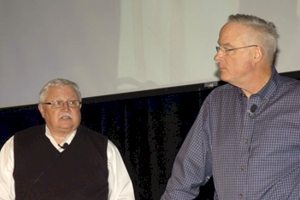Pork industry retooling not over, but continuing
Date posted: January 13, 2017

Steve Meyer (left) and Kevin Grier
Two of North America's best known pork market analysts told delegates at the Banff Pork Seminar that they believe the retooling in the Canadian and U.S. pork industry is neither over or about to increase. It is just continuing.
Steve Meyer of EMI Analytics, and Kevin Grier of Kevin Grier Marketing and Consulting are comfortable and entertaining speakers on pork market analysis and their tandem discussion on the retooling question closed out the 2017 Seminar in Banff, Alta.
Meyer cited five drivers that have driven the biggest changes in the U.S. pork industry and says all will continue to shape that industry in years ahead.
One is contract production. Born in the poultry business it changed how the industry viewed facility construction, labor, capital, economies of scale and geographic dispersion, says Meyer. Second is technology, "The term I use loosely to describe how we do things." That includes things like the application of statistical analysis to control swine production.
Driver three is superior genetics; four is federal grain price supports. Driver five is the specialization of everything, the biggest driver recently.
"Size allows people, vehicles, buildings, records, virtually everything to be optimized," says Meyer. "Labor and management specialization has been a key part of that and size allows specialized marketing, logistics, public relations and government relations, all with big advantages."
Canada can compete
One common question in Canada, says Grier, is whether the Canadian industry can compete. While Grier often hears that this industry is not competitive, he says the data does not support that. Trade balance figures show we can compete and Canada is clearly a global presence. Canadian production from 2012 to 2016 increased seven percent, while the world increased one percent and the EU four percent.
Canada increased exports the past four years while the U.S. decreased theirs. Canada's share of the Chia market increased. "We lost a bit globally due in part to the fact we lost Russia. International cost of production figures show Canada can compete. We aren't Iowa but then nobody is Iowa," says Grier.
Packer developments
There is some work to be done on the competiveness side in the packing industry in Canada. "They know that," he says.
Grier expects strong demand for Canadian weaners and feeders thanks to the growing U.S. hog industry and the weak Canadian dollar. He sees plant closures likely in the Quebec market, perhaps expansion in other areas. Expect the move to fewer, larger, more integrated operations to continue, he says.
On the trade front, while the Comprehensive Economic and Trade Agreement (CETA) is coming, he does not expect it to be a big deal for the Canadian hog industry.
Positive demand
One of the most important developments in the North American industry is the improvement in pork demand. In fact, it is not just an improvement in pork demand but in meat and poultry demand in general. It has been an unfortunate factor of the red meat industry, and pork in particular, that demand has been in decline for 20 or more years.
In 2014-2016 the erosion appears to have stopped. Not only have Canadians eaten more pork but given how high prices were, Canadian consumption was very robust. The U.S. demand behavior is almost exactly the same.
Demand is important because an industry with declining demand is an industry in decline. Conversely an industry with increasing demand is not necessarily growing, but at least it has the opportunity to grow.
Grier explains that demand is the combination of price and consumption. Just because consumption is rising or falling, does not mean demand is rising or falling. The price must be combined with the consumption to get a true picture of demand.
Demand is important to the health and growth of the pork industry. People readily look at supplies and slaughter as indicators of the potential for pricing and profit gains or losses. Part of the reason the industry looks so closely at supply and slaughter is because it is easy to grasp.
"We can all appreciate what it means to hog prices when we have short or long supplies," says Grier. "Obviously supplies and slaughter are critical but they only tell half the story. Demand on the other hand is more nebulous and we typically cannot get a statistical feel or gauge on demand until after the fact. Demand can make or break a market just as supplies can make or break a market."
Return to the News Release Index
